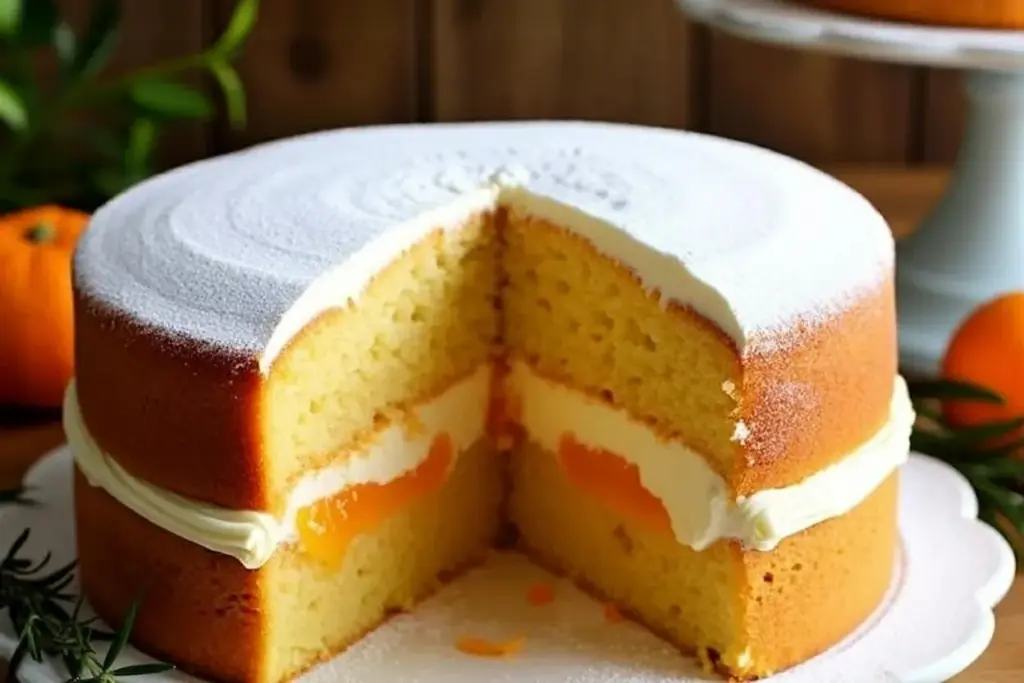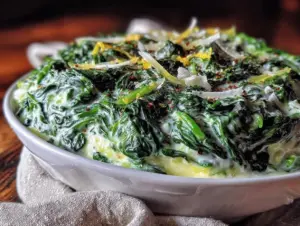There’s something magical about baking a cake that fills your kitchen with the warm, citrusy aroma of oranges. This Classic Orange Victoria Sponge Cake recipe is the perfect addition to your tea-time spread. With its light, fluffy texture and zesty orange flavor, this timeless dessert is guaranteed to impress both family and friends. Whether you’re hosting an elegant afternoon tea or simply indulging in a slice with your favorite cuppa, this recipe will quickly become a favorite.
Inspired by the traditional Victoria sponge cake, this version adds a delightful orange twist that takes the classic to a whole new level. Trust me, once you taste this, you’ll wonder why oranges haven’t always been part of the equation!
The Story Behind the Orange Victoria Sponge Cake
The Victoria sponge cake has a long and delicious history, named in honor of Queen Victoria herself. Known for her love of simple yet elegant cakes, the Victoria sponge became a staple of afternoon tea in 19th-century England. Traditionally made with just eggs, sugar, flour, and butter, its simplicity allowed the quality of the ingredients to shine.
My twist on this classic dessert comes from my love of oranges. Growing up, my grandmother would always keep a bowl of fresh oranges on the counter, and their vibrant color and refreshing aroma became synonymous with comfort for me. One day, while baking a traditional Victoria sponge, I decided to add some freshly grated orange zest and juice to the batter—and the result was this delightful cake!
Over the years, I’ve made this recipe for birthdays, holidays, and even just-because days. It’s a cake that feels special yet remains understated, like a quiet hug in dessert form. And the orange flavor? It adds a bright, sunny note that pairs beautifully with the buttery richness of the sponge.
Let’s Talk Ingredients
To make the best Classic Orange Victoria Sponge Cake, it’s important to start with quality ingredients. Here’s a guide to what you’ll need:
- Unsalted Butter: Use room-temperature butter for a smooth, creamy batter. If you’re in a pinch, salted butter will work, but reduce the added salt in the recipe.
- Caster Sugar: This superfine sugar dissolves quickly, creating a light and airy sponge. Granulated sugar can be used, but the texture may be slightly different.
- Eggs: Fresh, room-temperature eggs are key for a stable and fluffy batter. Large eggs work best here.
- Self-Raising Flour: This flour already contains baking powder, which gives your cake the perfect rise. If you don’t have any on hand, you can make your own by adding 2 teaspoons of baking powder to 1 cup of all-purpose flour.
- Orange Zest and Juice: The star of the show! Choose fresh, unwaxed oranges for the best flavor. The zest provides concentrated citrus notes, while the juice adds moisture and tang.
- Heavy Cream: For the filling, whip heavy cream to soft peaks. It’s the perfect balance to the sweet sponge.
- Orange Marmalade: A thin layer of marmalade in the filling enhances the orange flavor and adds a slight bitterness to balance the sweetness.
- Powdered Sugar: A light dusting on top gives the cake its signature look.
If you’re making this for someone with dietary restrictions, here are some handy swaps:
- For a gluten-free version, use a gluten-free self-raising flour blend.
- If you’re dairy-free, replace the butter with a plant-based alternative and use coconut cream instead of heavy cream.
- Vegan? Use flax eggs (1 tablespoon flaxseed meal + 3 tablespoons water per egg) and plant-based cream.
Equipment You’ll Need
Making this cake doesn’t require fancy gadgets, but here’s what you’ll need:
- Two 8-inch (20 cm) Cake Pans: These will give you the perfect layers. Make sure they’re greased and lined with parchment paper.
- Electric Mixer: A stand mixer or hand mixer will make creaming the butter and sugar a breeze.
- Microplane Zester: Essential for finely grating the orange zest without the bitter pith.
- Spatula: For folding the batter gently to keep it light and airy.
- Wire Rack: Cooling your cakes on a rack prevents soggy bottoms.
If you don’t have cake pans, you can use a single springform pan and slice the cake into layers after it cools. Just adjust the baking time accordingly.
How to Make a Classic Orange Victoria Sponge Cake
- Preheat your oven: Set it to 350°F (175°C) and grease and line your cake pans.
- Cream the butter and sugar: Beat 1 cup (225 g) of butter with 1 cup (200 g) of caster sugar until pale and fluffy. This should take about 3-4 minutes.
- Add the eggs: Beat in 4 large eggs, one at a time, ensuring each is fully incorporated before adding the next.
- Mix in the orange: Stir in 1 tablespoon of orange zest and 2 tablespoons of freshly squeezed orange juice.
- Fold in the flour: Gently fold in 2 cups (250 g) of self-raising flour using a spatula. Be careful not to overmix!
- Bake: Divide the batter evenly between the pans and bake for 20-25 minutes, or until a toothpick inserted in the center comes out clean.
- Cool: Let the cakes cool in the pans for 10 minutes before transferring them to a wire rack.
- Make the filling: Whip 1 cup (240 ml) of heavy cream with 2 tablespoons of powdered sugar until soft peaks form.
- Assemble: Spread a thin layer of orange marmalade on one cake layer, followed by the whipped cream. Place the second layer on top.
- Decorate: Dust the top with powdered sugar and garnish with a few twists of orange zest, if desired.
Tips for Perfect Results
Here are some tips to make sure your Orange Victoria Sponge Cake turns out beautifully:
- Don’t rush the creaming process—it’s the key to a light sponge.
- Use room-temperature ingredients for a smooth batter.
- Check your cakes a few minutes before the baking time ends to avoid overbaking.
- If your layers dome in the center, level them with a serrated knife before assembling.
Variations and Adaptations
This recipe is incredibly versatile. Here are some ideas to switch it up:
- Seasonal Twist: Swap the orange for lemon or lime for a different citrus flavor.
- Chocolate Lovers: Add 2 tablespoons of cocoa powder and orange zest for a chocolate-orange sponge.
- Nutty Addition: Fold in 1/4 cup (40 g) of finely chopped almonds or hazelnuts for added texture.
Feel free to experiment with different jams or fillings to suit your taste!
Serving and Storage
Serve this cake at room temperature with a hot cup of tea or coffee. It’s also lovely with a dollop of whipped cream or a scoop of vanilla ice cream.
To store, keep the cake in an airtight container at room temperature for up to 2 days. For longer storage, refrigerate for up to 5 days, but let it come to room temperature before serving. You can also freeze the unfilled cake layers for up to 3 months—just wrap them tightly in plastic wrap and foil.
Nutritional Information and Benefits
This cake is a treat, so enjoy it in moderation! A slice contains approximately:
- Calories: 320
- Fat: 18 g
- Sugar: 25 g
- Protein: 4 g
The orange zest and juice provide a boost of vitamin C, while the eggs contribute protein and essential nutrients. Always check ingredient labels for allergens if serving to guests.
Conclusion
This Classic Orange Victoria Sponge Cake is a delightful twist on a beloved classic. Its bright, citrusy flavor and fluffy texture make it the perfect centerpiece for any tea-time gathering. I hope you enjoy baking (and eating!) this cake as much as I do.
If you give this recipe a try, let me know in the comments below! I’d love to hear about your experience, any tweaks you made, or how you served it. Happy baking, and enjoy every zesty bite!
FAQs
Can I make this cake ahead of time?
Yes! You can bake the layers a day in advance and store them tightly wrapped. Assemble the cake just before serving for the freshest taste.
What’s the best way to zest an orange?
Use a microplane zester and avoid the white pith—it’s bitter! Grate just the bright orange outer layer.
Can I use orange extract instead of fresh oranges?
Fresh oranges are best, but in a pinch, you can use 1 teaspoon of orange extract.
What if I don’t have self-raising flour?
You can make your own by mixing 1 cup of all-purpose flour with 2 teaspoons of baking powder.
Can I freeze the assembled cake?
It’s better to freeze the layers separately and assemble after thawing. This keeps the cream filling fresh.
Print
Classic Orange Victoria Sponge Cake
- Total Time: 40 minutes
- Yield: 8 servings 1x
Description
A delightful twist on the traditional Victoria sponge cake, featuring zesty orange flavor and a light, fluffy texture perfect for tea-time gatherings.
Ingredients
- 1 cup (225 g) unsalted butter, room temperature
- 1 cup (200 g) caster sugar
- 4 large eggs, room temperature
- 2 cups (250 g) self-raising flour
- 1 tablespoon orange zest
- 2 tablespoons freshly squeezed orange juice
- 1 cup (240 ml) heavy cream
- 2 tablespoons powdered sugar
- 2 tablespoons orange marmalade
- Powdered sugar for dusting
Instructions
- Preheat your oven to 350°F (175°C) and grease and line two 8-inch (20 cm) cake pans.
- Cream the butter and sugar together until pale and fluffy, about 3-4 minutes.
- Beat in the eggs one at a time, ensuring each is fully incorporated before adding the next.
- Stir in the orange zest and orange juice.
- Gently fold in the self-raising flour using a spatula, being careful not to overmix.
- Divide the batter evenly between the pans and bake for 20-25 minutes, or until a toothpick inserted in the center comes out clean.
- Let the cakes cool in the pans for 10 minutes before transferring them to a wire rack.
- Whip the heavy cream with powdered sugar until soft peaks form.
- Spread a thin layer of orange marmalade on one cake layer, followed by the whipped cream. Place the second layer on top.
- Dust the top with powdered sugar and garnish with orange zest, if desired.
Notes
Use room-temperature ingredients for a smooth batter. Check your cakes a few minutes before the baking time ends to avoid overbaking. If your layers dome in the center, level them with a serrated knife before assembling.
- Prep Time: 15 minutes
- Cook Time: 25 minutes
- Category: Dessert
- Cuisine: British
Nutrition
- Serving Size: 1 slice
- Calories: 320
- Sugar: 25
- Fat: 18
- Protein: 4
Keywords: Victoria sponge cake, orange cake, tea-time dessert, citrus cake, classic dessert



